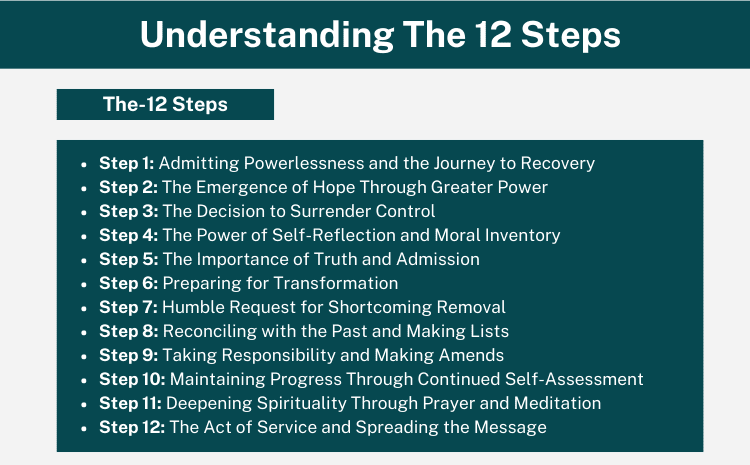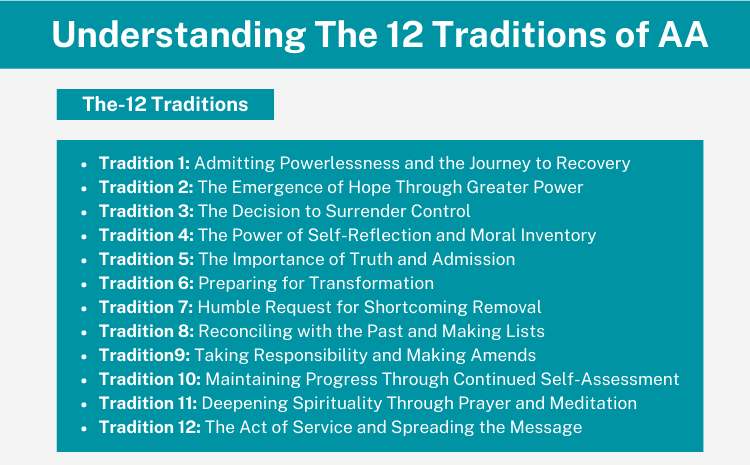Understanding the 12 Steps: A Comprehensive Guide to AA’s Path to Recovery
Stepping into the realm of recovery, the name ‘Alcoholics Anonymous,’ commonly referred to as ‘AA’, surfaces frequently. An influential worldwide organization, AA was initiated in the mid-1930s by two men – Bill Wilson and Dr. Bob Smith. These pioneers grappled with their personal battles against alcohol and sought to construct a supportive community for individuals with similar struggles.
The seeds of alcoholics anonymous were sown during a meeting between Wilson and Smith in Akron, Ohio. The two men discovered the power of shared experiences and mutual support, marking the first roots of the Alcoholics Anonymous movement. From here, they crafted the 12 principles of AA, which are the foundation of the organization’s approach to recovery and an essential roadmap for millions.
Their vision was influenced by the teachings of the Oxford Group, a Christian organization active during the early 20th century. This group emphasized the importance of moral inventory, confession, and making amends – elements that would later shape the core principles of AA.
Since its founding, Alcoholics Anonymous has grown exponentially, leaving an indelible mark on the landscape of addiction recovery. As we delve further into the organization’s legacy, we will unveil the specifics of each of the 12 steps, laying bare the pathway AA provides for overcoming addiction.
A Detailed Exploration of the 12 Steps
Embarking on the detailed exploration of the 12 steps, we initiate this journey with the first stage that forms the very bedrock of the Alcoholics Anonymous recovery process.

Step 1: Admitting Powerlessness and the Journey to Recovery
Step 1 involves acknowledging our powerlessness over alcohol. By accepting our unmanageable situation, we start to understand the principles of Alcoholics Anonymous that lay emphasis on humility and honesty. This recognition of powerlessness is the cornerstone of the 12 steps program, setting the stage for the transformative journey ahead.
Step 2: The Emergence of Hope Through Greater Power
Step 2 ushers in a ray of hope, as it invites us to believe in a power greater than ourselves— a “Higher Power” that can restore sanity. While the term “higher power” remains open to individual interpretation, it primarily suggests an external source of strength and resilience to counteract our struggles with alcohol.
Step 3: The Decision to Surrender Control
The third step presents the principle of surrender. It encourages us to relinquish control, turning our will and lives over to the care of the “God” as we understand Him. Surrendering doesn’t imply defeat, but rather it constitutes a strategic retreat in the battle against addiction.
Step 4: The Power of Self-Reflection and Moral Inventory
The 4th step emphasizes the importance of self-reflection. Making a searching and fearless moral inventory of ourselves enables us to analyze our behaviors and attitudes critically. This moral inventory is a courageous inward journey that lays bare the truths about our addiction
Step 5: The Importance of Truth and Admission
Step 5 accentuates the value of truth and admission. We are encouraged to confess our wrongs to ourselves, to God, and to other human beings. The act of admission signifies an important step towards unburdening our conscience and accepting our past mistakes.
Step 6: Preparing for Transformation
As we transition to Step 6, we prepare ourselves for a significant transformation. We express readiness to have God remove all these defects of character. This stage requires a willingness to undergo change and embark on a transformative journey.
Step 7: Humble Request for Shortcoming Removal
Step 7 calls for humility as we ask Him to remove our shortcomings. It’s a request for personal betterment and a stride towards embracing our improved selves.
Step 8: Reconciling with the Past and Making Lists
Moving on to Step 8, it necessitates a confrontation with the past. We make a list of all persons we’ve harmed and express a willingness to make amends, signifying our readiness to reconcile with the past and make peace with those we’ve wronged.
Step 9: Taking Responsibility and Making Amends
Step 9 urges us to take responsibility for our actions. Making direct amends to those we have harmed signifies a crucial act of acceptance and responsibility, cultivating empathy and understanding in the process.
Step 10: Maintaining Progress Through Continued Self-Assessment
As we reach Step 10, we learn the importance of progress and self-assessment. We commit to continue our personal inventory, promptly admitting when we are wrong. This step reinforces the necessity of ongoing self-evaluation and correction for lasting recovery.
Step 11: Deepening Spirituality Through Prayer and Meditation
Step 11 involves deepening our spirituality. It promotes improving our conscious contact with God through prayer and meditation. This spiritual practice provides us the serenity and inner strength to continue on our path to recovery.
Step 12: The Act of Service and Spreading the Message
Finally, Step 12 embodies the spirit of service. Having undergone a spiritual awakening as a result of these steps, we try to carry this message to alcoholics and practice these principles in all our affairs. This step represents the culmination of our journey, reminding us of the power and the potential of the AA’s 12 step program.
In the next sections, we will delve into how these steps translate into real-life experiences, the challenges one may face, and the strategies for overcoming them.
AA's Twelve Traditions: The Guiding Principles Behind the 12 Steps

While the 12 Steps offer a spiritual course for personal recovery, the AA traditions guide the conduct of the group as a whole. These traditions, just like the steps, are based on experience and guided by the principles of unity, service, and recovery.
- Tradition 1 reminds us that our common welfare should come first, reinforcing the interconnectedness of individual and collective well-being. This tradition underscores that Alcoholics Anonymous functions as a cooperative entity, reliant on its members’ shared experience, strength, and hope.
- Tradition 2 recognizes a single ultimate authority: a loving God as expressed in our group conscience. This tradition provides a democratic structure that respects each member’s voice and trusts in the collective wisdom.
- Tradition 3 advocates inclusivity, maintaining that the only requirement for AA membership is a desire to stop drinking. This tradition emphasizes the open-door policy of AA, with no judgment or preconditions.
- Tradition 4 underlines the autonomy and responsibility of each AA group, respecting its internal affairs while ensuring the welfare of Alcoholics Anonymous as a whole. This tradition ensures a balance between independence and unity, between local concerns and the collective welfare.
- Tradition 5 asserts the primary purpose of every AA group: to carry its message to the alcoholic who still suffers. This tradition reaffirms the commitment to service, highlighting the importance of reaching out to those in need.
- Tradition 6 cautions against potential distractions from our primary spiritual aim. This tradition advises that substantial properties should be managed separately, keeping the focus on the mission of recovery.
- Tradition 7 states that AA should be self-supporting through the voluntary contributions of its members, maintaining financial independence and avoiding disputes over funds that could hamper the spiritual journey.
- Tradition 8 upholds the principle of service, asserting that AA should remain forever non-professional. While special services may be compensated, the heart of AA’s work, the “12th Step” work, is never to be paid for.
- Tradition 9 suggests minimal organization, advocating for rotating leadership. This tradition rejects the idea of hierarchy and promotes the spirit of equality and democracy.
- Tradition 10 calls for neutrality on controversial issues, ensuring that AA doesn’t endorse or oppose any external causes. This tradition fosters a spirit of unity, focusing solely on the common goal of recovery.
- Tradition 11 promotes anonymity and humility in public relations. Instead of self-promotion, AA relies on the principle of attraction, letting the effectiveness of the program speak for itself.
- Tradition 12 the capstone of all the traditions, underscores the importance of anonymity, placing principles before personalities. This tradition promotes humility and selflessness, reminding us that the greater purpose is always more important than individual egos.
The Twelve Traditions, with their emphasis on unity, service, and recovery, provide a framework for how AA groups can function in a harmonious and effective way. This balance between individual recovery and collective functioning ensures the continued vitality of the AA fellowship. Now, let’s explore how these principles and traditions are reflected in AA meetings.
The Effectiveness and Timeline of the 12-Step Program
One of the distinguishing characteristics of Alcoholics Anonymous and the twelve step program is that they are not ‘quick-fix’ solutions; rather, they are sustained commitments to a new way of living. But how long does it typically take for someone to work through the 12 steps? This timeline can differ greatly from person to person, given the deeply personal nature of the journey.
A common piece of advice for newcomers is to attend “90 meetings in 90 days,” equating to one meeting per day for three months. However, this isn’t a strict rule. The timeline isn’t the focus when working through the 12 steps; instead, it is the depth and sincerity of engagement with each step that matters most.
Evaluating the effectiveness of Alcoholics Anonymous and the Twelve Steps program presents certain challenges, given the inherent variability and self-selecting nature of the membership. While approximately 40 percent of AA members discontinue their participation within the first year, studies have often associated longer-term participation with successful sobriety.
One particularly well-regarded study known as Project Match, published in 1997, suggested promising outcomes for AA participants. This research compared the efficacy of an AA-based treatment with cognitive-behavioral therapy and motivational enhancement therapy, finding comparable rates of sobriety across all three groups after a year.
However, these findings don’t necessarily apply to all problem drinkers or AA groups. The self-selecting nature of AA membership and the varying structure of meetings and treatments may lead to different results. It’s also important to note that the reported abstinence rates might be more applicable to individuals with less severe alcohol issues, given the selection criteria of the studies.
Analyzing the Pros and Cons of the 12-Step Program
As with any treatment approach, the twelve steps program comes with its own set of advantages and drawbacks. Here, we’ll highlight some of the main pros and cons to provide a balanced overview of this widely-used recovery method.
12-Step Program Pros
- Accessibility: AA and other 12-step programs are available in nearly every city across the globe, ensuring help is within reach regardless of location. Many groups also offer online meetings, further increasing accessibility.
- Cost-effectiveness: Since Alcoholics Anonymous is a voluntary organization run by its members, there are no fees or costs associated with attending meetings, making it an affordable option for everyone.
- Peer support: One of the biggest strengths of the Twelve Steps program is the robust community of individuals in recovery who support each other. The sense of belonging, understanding, and mutual support can be incredibly beneficial.
- Long-term focus: Unlike many treatment programs that have a set end date, the 12-step program encourages lifelong commitment, aiding in long-term sobriety.
12-Step Program Cons
- Religious undertones: The program’s reliance on a “Higher Power” can be a hurdle for those uncomfortable with religious or spiritual elements.
- Lack of professional supervision: While peer support is a strength of the program, the lack of professional therapeutic supervision can be a drawback for those needing clinical intervention.
- One-size-fits-all approach: The program is designed as a universal solution for all, which can potentially ignore individual differences in experience, causes of addiction, and recovery needs.
- Absence of coping strategies: The 12 step program doesn’t explicitly teach coping mechanisms for dealing with triggers or cravings, a critical aspect of recovery that is usually addressed in therapy.
The Role of Spirituality in the 12-Step Program
At the heart of the twelve steps program is a profound emphasis on spirituality, although it’s crucial to note that the program does not align itself with any particular religious denomination. The spiritual principles embedded in the 12 steps, such as surrendering to a higher power, taking moral inventory, making amends, and carrying the message to others, serve as the program’s spiritual foundation.
A key tenet of this approach is the notion of a ‘spiritual awakening’ – a transformative experience leading to recovery from alcoholism. This shift often involves a newfound understanding of one’s place in the world and a reconnection with a sense of purpose.
The spiritual element of the 12-step program is not about adhering to a specific faith but about harnessing the power of spiritual principles in service of healing and recovery. In the next section, we will discuss the potential of alternatives to the 12-step program for those seeking different paths to recovery.
Exploring Alternatives to AA's 12-Step Program
Although the Twelve Steps program is a widely recognized approach to addiction recovery, it is not the only option available. For individuals seeking a different path, there are several alternatives:
SMART Recovery (Self-Management and Recovery Training): Unlike AA’s spirituality-focused program, SMART Recovery is grounded in cognitive-behavioral therapy and emphasizes self-empowerment. Its 4-Point Program includes coping with urges, managing thoughts and behaviors, building and living a balanced life, and maintaining motivation to abstain.
Secular Organizations for Sobriety (S.O.S.): For those uncomfortable with the spiritual elements of the 12-step program, S.O.S. offers a secular recovery path. This group emphasizes the individual’s role in managing their recovery while providing a supportive, non-religious network.
Professional Treatment: Therapy and counseling can be invaluable for those struggling with addiction. Cognitive-behavioral therapy, motivational interviewing, and family therapy are common methods used in addiction treatment. Often, these treatments can be combined with group support, like in AA, for a comprehensive recovery approach.
While each of these alternatives offers its unique benefits, it’s essential to remember that recovery is a deeply personal journey. The best approach will vary based on individual needs, preferences, and circumstances.
Start the Recovery Journey
Taking the first step towards recovery can often be the most daunting. Understand that it’s okay to feel uncertain or overwhelmed, and remember, you’re not alone in this journey. Whether you choose to follow the AA Twelve Steps program or participate in alternative programs like SMART Recovery or S.O.S., the most important thing is that you’re taking steps towards recovery. Every path to sobriety is unique, and what works for one person might not work for another. The crucial part is to be open, patient, and forgiving with yourself throughout this process. Remember, recovery is not a destination but a lifelong journey.
